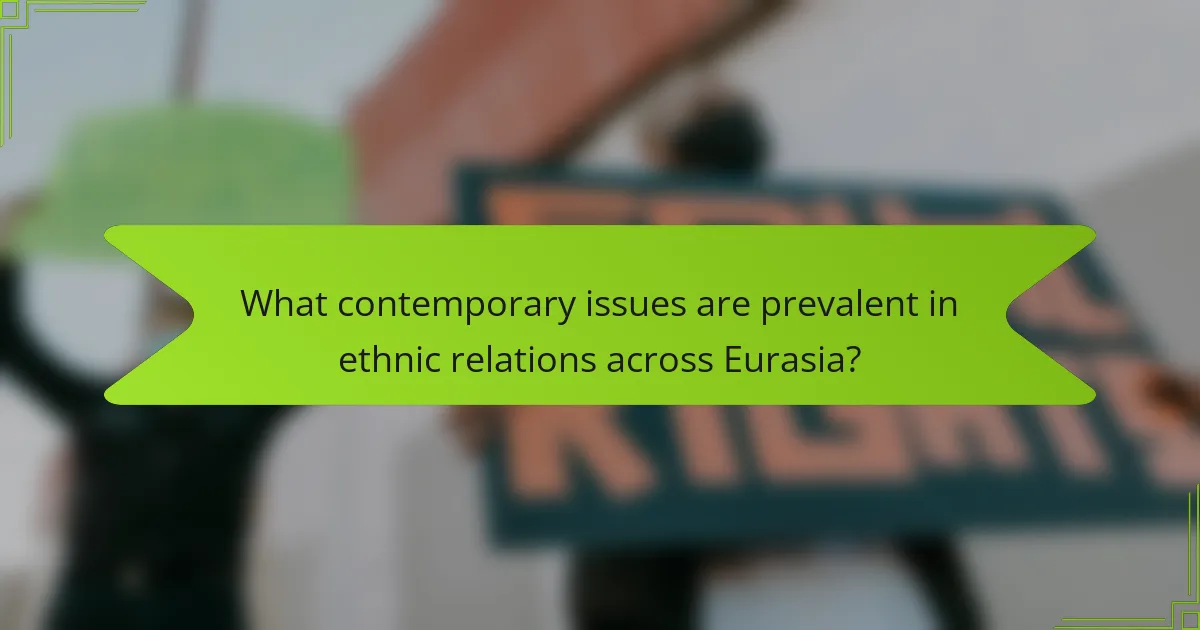The article examines the dynamics of ethnic relations in Eurasia, focusing on historical legacies, economic disparities, and political governance as key influencing factors. It highlights how the dissolution of the Soviet Union has led to ethnic tensions, exacerbated by competition for limited resources and varying political systems. Contemporary issues such as ethnic conflict, nationalism, and migration are discussed, along with the impact of state policies on ethnic minorities. The article emphasizes the importance of dialogue, education, and inclusive governance in promoting understanding and improving relations among diverse ethnic groups in the region.

What are the key factors influencing ethnic relations in Eurasia?
Key factors influencing ethnic relations in Eurasia include historical legacies, economic disparities, and political governance. Historical legacies shape group identities and perceptions. For instance, the Soviet Union’s dissolution led to ethnic tensions in various regions. Economic disparities often exacerbate grievances among ethnic groups. Regions with limited resources may see increased competition and conflict. Political governance plays a crucial role in managing ethnic relations. Authoritarian regimes may suppress ethnic identities, while democratic systems can promote inclusivity. Additionally, external influences, such as foreign policies, can impact inter-ethnic dynamics. For example, international support for certain ethnic groups can alter power balances. These factors collectively contribute to the complex landscape of ethnic relations in Eurasia.
How has historical context shaped contemporary ethnic relations?
Historical context has profoundly shaped contemporary ethnic relations through patterns of migration, conflict, and colonialism. Historical migrations have established diverse ethnic communities in various regions. For example, the movement of peoples during the Soviet era created multi-ethnic states in Central Asia. Conflicts, such as the Yugoslav Wars, have left lasting tensions and divisions among ethnic groups. Colonialism imposed arbitrary borders that often disregarded ethnic boundaries, leading to ongoing disputes. Additionally, historical grievances, such as land dispossession, continue to influence modern ethnic identities and relations. The legacy of these historical events is evident in contemporary policies and social dynamics.
What significant historical events have impacted ethnic dynamics?
Colonialism significantly impacted ethnic dynamics across various regions. It often led to the forced migration of populations. This migration resulted in a mix of ethnic groups in new areas. Additionally, colonial powers imposed artificial borders. These borders frequently disregarded existing ethnic territories. The World Wars also reshaped ethnic relations. They caused large-scale displacements and shifts in population demographics. Post-war treaties often redrew national boundaries. This redrawing sometimes exacerbated ethnic tensions. The fall of empires, such as the Ottoman Empire, led to new nation-states. These nations frequently faced ethnic conflicts as diverse groups sought autonomy. The breakup of the Soviet Union in the 1990s further altered ethnic dynamics. It resulted in independence for several ethnic groups and subsequent conflicts. Each of these events has had lasting effects on ethnic interactions and identities.
How do colonial legacies affect current ethnic relations?
Colonial legacies significantly influence current ethnic relations by perpetuating divisions and inequalities. Historical colonial practices often created hierarchies among ethnic groups. These hierarchies can lead to ongoing tensions and conflicts. For example, in many post-colonial states, former colonial powers favored certain ethnic groups over others. This favoritism has resulted in lasting disparities in political power and economic opportunities.
Additionally, colonial borders often disregarded ethnic and cultural boundaries. This has caused fragmented communities and inter-ethnic conflicts. In regions like Africa and Asia, such divisions continue to fuel violence and discrimination. Furthermore, the cultural imposition during colonial times has led to identity crises among indigenous populations.
The impact of these legacies is evident in contemporary social dynamics. Ethnic groups often struggle for recognition and rights in states shaped by colonial history. Research indicates that unresolved historical grievances can hinder reconciliation efforts. Overall, colonial legacies create a complex landscape for ethnic relations today.
What roles do culture and identity play in ethnic relations?
Culture and identity significantly influence ethnic relations by shaping perceptions, interactions, and power dynamics among different groups. Cultural practices, values, and beliefs often dictate how ethnic groups view one another. Shared identity fosters solidarity within a group, while distinct identities can lead to misunderstandings or conflicts with others. Historical context plays a crucial role in these dynamics. For example, colonial histories have left lasting impacts on ethnic relations in many regions. Ethnic identity can also be a source of pride or a basis for discrimination. Studies show that cultural exchanges can enhance mutual understanding, while cultural misunderstandings can escalate tensions. Therefore, culture and identity are central to navigating the complexities of ethnic relations.
How do cultural differences contribute to ethnic tensions?
Cultural differences contribute to ethnic tensions by creating misunderstandings and conflicts between groups. Distinct values, beliefs, and practices can lead to perceptions of superiority or inferiority. For example, differing religious practices may result in exclusion or discrimination. Language barriers can hinder communication and foster resentment. Historical grievances often resurface due to cultural differences, intensifying tensions. Research shows that societies with high cultural diversity may experience more ethnic conflict, as seen in the former Yugoslavia. In contrast, societies that promote multiculturalism tend to have lower levels of ethnic tension.
What is the impact of national identity on ethnic relations?
National identity significantly influences ethnic relations. It can foster unity among members of the dominant ethnic group. This often leads to the marginalization of minority groups. National identity may also shape policies that affect resource distribution. For example, in many countries, national identity can dictate language and education policies. Such policies can either promote inclusion or reinforce divisions. Historical examples include the former Yugoslavia, where national identity contributed to ethnic conflict. In contrast, inclusive national identities can enhance social cohesion and mutual respect among diverse ethnic groups.

What contemporary issues are prevalent in ethnic relations across Eurasia?
Contemporary issues prevalent in ethnic relations across Eurasia include ethnic conflict, nationalism, and migration. Ethnic conflict arises from historical grievances and competition for resources. Nationalism often fuels tensions between different ethnic groups. Migration, both voluntary and forced, alters demographic landscapes and can lead to cultural clashes. Additionally, state policies can exacerbate ethnic disparities. For example, in countries like Russia and Ukraine, ethnic minorities face discrimination and marginalization. These dynamics create complex challenges for social cohesion and stability in the region.
How do political frameworks influence ethnic conflicts?
Political frameworks significantly influence ethnic conflicts by shaping power dynamics and resource distribution. They determine the legal status of ethnic groups and their access to political representation. For instance, centralized political systems often marginalize minority groups, leading to tensions. In contrast, federal systems may provide more autonomy, which can reduce conflict. Historical examples include the Yugoslav Wars, where political fragmentation fueled ethnic violence. Additionally, policies promoting national identity can exacerbate divisions. The 1994 Rwandan Genocide illustrates how political rhetoric can incite violence against ethnic groups. Thus, the structure and policies of political frameworks are crucial in either mitigating or escalating ethnic conflicts.
What are the effects of government policies on ethnic minorities?
Government policies can significantly affect ethnic minorities in various ways. These effects include social, economic, and political dimensions. Policies may lead to increased discrimination or marginalization of ethnic groups. For instance, restrictive immigration laws can limit opportunities for minority communities. Educational policies may either promote inclusion or reinforce segregation. Economic policies can create disparities in access to resources and job opportunities. Historical examples include the impact of apartheid in South Africa, which institutionalized racial discrimination. Conversely, affirmative action policies can improve representation and access for ethnic minorities. The outcomes of these policies often depend on their design and implementation. Overall, government policies play a crucial role in shaping the experiences and rights of ethnic minorities.
How do political movements shape ethnic relations in the region?
Political movements significantly influence ethnic relations in the region by altering power dynamics and social structures. These movements often advocate for the rights and recognition of specific ethnic groups. They can lead to increased tensions or cooperation among different ethnic communities. For instance, nationalistic movements may elevate the status of one ethnic group at the expense of others. Conversely, inclusive political movements can foster dialogue and collaboration among diverse groups. Historical examples include the dissolution of the Soviet Union, which reshaped ethnic boundaries and relationships. The rise of ethnic political parties can also mobilize support and create divisions. Overall, political movements serve as catalysts for both conflict and unity in ethnic relations.
What economic factors contribute to ethnic disparities?
Economic factors contributing to ethnic disparities include income inequality, employment opportunities, and access to education. Income inequality often affects ethnic minorities disproportionately, leading to lower overall economic status. Employment opportunities can be limited for certain ethnic groups due to discrimination or lack of networks. Access to education is frequently unequal, impacting job qualifications and economic mobility for these groups. A report by the OECD indicates that education gaps can lead to significant income disparities, particularly for marginalized ethnic communities. Additionally, historical economic policies have perpetuated systemic disadvantages for specific ethnic groups, further entrenching disparities.
How does access to resources affect ethnic group relations?
Access to resources significantly influences ethnic group relations. When resources are scarce, competition among ethnic groups intensifies. This competition can lead to tensions and conflicts. For example, in regions with limited water or land, ethnic groups may clash over access. Conversely, equitable resource distribution can foster cooperation and harmony. Historical instances show that shared resources often lead to alliances among groups. In contrast, unequal resource access can exacerbate grievances and fuel discrimination. Studies indicate that resource wealth can either unite or divide communities, depending on management and equity.
What role does economic inequality play in ethnic tensions?
Economic inequality significantly exacerbates ethnic tensions. Disparities in wealth and resources often lead to feelings of resentment among marginalized ethnic groups. When one ethnic group experiences systemic economic disadvantage, it can foster perceptions of injustice and exclusion. This can result in social unrest and conflict. Historical examples illustrate this dynamic, such as the ethnic tensions in the former Yugoslavia, where economic disparities contributed to violent conflict. Moreover, research indicates that areas with high economic inequality often witness increased ethnic strife. The World Bank highlights that economic inequality can undermine social cohesion and stability. Thus, economic inequality plays a crucial role in fueling ethnic tensions.

What strategies can be employed to improve ethnic relations in Eurasia?
Promoting dialogue and understanding among ethnic groups can improve ethnic relations in Eurasia. Initiatives like intercultural exchanges foster mutual respect. Educational programs that highlight shared histories can reduce prejudice. Inclusive political representation ensures all groups have a voice. Conflict resolution mechanisms can address grievances peacefully. Collaborative economic projects can create interdependence and reduce tensions. Community-led initiatives encourage grassroots involvement in promoting harmony. Historical reconciliation processes can heal past wounds and build trust.
How can dialogue and communication foster better understanding?
Dialogue and communication can foster better understanding by facilitating the exchange of perspectives. This process allows individuals to articulate their thoughts and feelings clearly. When people engage in open dialogue, they can address misunderstandings directly. Effective communication encourages active listening, which helps to validate others’ experiences. Research indicates that dialogue reduces stereotypes and promotes empathy. For example, studies show that structured dialogues in diverse groups lead to improved relationships. In conflict situations, communication can de-escalate tensions and build trust. Overall, dialogue serves as a crucial tool for bridging cultural divides and enhancing mutual respect.
What initiatives promote inter-ethnic cooperation?
Initiatives that promote inter-ethnic cooperation include cultural exchange programs, dialogue forums, and joint community projects. Cultural exchange programs foster understanding by allowing different ethnic groups to share traditions and customs. Dialogue forums provide a platform for open discussions about ethnic issues and grievances. Joint community projects encourage collaboration on common goals, strengthening relationships among diverse groups. Evidence shows that such initiatives can reduce tensions and build trust. For instance, the United Nations has supported various programs aimed at enhancing inter-ethnic dialogue in conflict-prone areas.
How can education contribute to reducing ethnic conflict?
Education can contribute to reducing ethnic conflict by promoting understanding and tolerance among diverse groups. It fosters critical thinking and encourages dialogue about cultural differences. Educational programs can include curricula that highlight shared histories and common values. Research shows that inclusive education reduces prejudices and stereotypes. For instance, a study by the United Nations Educational, Scientific and Cultural Organization (UNESCO) indicates that intercultural education can decrease tensions. Furthermore, education can empower marginalized communities, giving them a voice in societal matters. This empowerment can lead to more equitable resource distribution and representation. Overall, education serves as a foundation for peaceful coexistence and conflict resolution.
What role does international cooperation play in resolving ethnic issues?
International cooperation is crucial in resolving ethnic issues. It facilitates dialogue and understanding among conflicting groups. Collaborative efforts often lead to peaceful negotiations and conflict resolution. Organizations like the United Nations promote frameworks for addressing ethnic tensions. For instance, peacekeeping missions help stabilize regions experiencing ethnic strife. International treaties can also establish protections for minority rights. Additionally, shared resources and expertise can aid in rebuilding trust between communities. Historical examples, such as the Dayton Agreement, illustrate the effectiveness of international mediation in ethnic conflicts.
How can global organizations support ethnic harmony in Eurasia?
Global organizations can support ethnic harmony in Eurasia by promoting dialogue and collaboration among diverse ethnic groups. They can facilitate peacebuilding initiatives that address historical grievances. These organizations can also provide funding for community development projects that encourage inter-ethnic cooperation. Monitoring and reporting on ethnic tensions can help raise awareness and prompt action. Educational programs promoting cultural understanding can foster respect among different communities. Additionally, global organizations can advocate for policies that protect minority rights. Their involvement in conflict resolution can lead to sustainable peace agreements. Such efforts contribute to a more harmonious and integrated Eurasian society.
What examples of successful interventions exist in the region?
Successful interventions in the region include the peace agreement in Bosnia and Herzegovina. This agreement was brokered in 1995 after the Bosnian War. It established a framework for power-sharing among ethnic groups. The Dayton Accords significantly reduced ethnic tensions. Another example is the reconciliation efforts in Georgia after the civil conflicts. These efforts focused on community dialogue and integration. They aimed to address grievances among different ethnic groups. Additionally, the European Union’s involvement in the Western Balkans has promoted stability. EU initiatives have fostered economic cooperation and political dialogue. These interventions demonstrate effective strategies for managing ethnic relations in Eurasia.
What practical steps can individuals take to promote ethnic harmony?
Individuals can promote ethnic harmony by engaging in open dialogue with diverse groups. This fosters understanding and reduces misconceptions. Participating in community events that celebrate various cultures enhances mutual respect. Volunteering for organizations that support multicultural initiatives builds connections across ethnic lines. Educating oneself about different cultures and histories increases awareness and empathy. Challenging stereotypes and prejudices in conversations contributes to a more inclusive environment. Supporting policies that advocate for equality and representation in governance promotes systemic change. These actions collectively create a foundation for lasting ethnic harmony.
The main entity of the article is ethnic relations in Eurasia, encompassing the historical context and contemporary issues that shape these dynamics. Key factors influencing these relations include historical legacies, economic disparities, political governance, culture, and identity. The article examines how colonialism, migration, and national identity impact ethnic dynamics, while also addressing contemporary challenges such as ethnic conflict, nationalism, and government policies. Strategies for improving ethnic relations, including dialogue, education, and international cooperation, are also discussed, providing a comprehensive overview of the complexities surrounding ethnic interactions in the region.